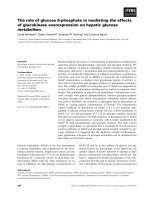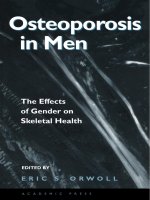Mitochondrial integrity and antioxidative enzyme efficiency in fischer rats effects of ageing and epigallocatechin 3 gallate intervention 1 3
Bạn đang xem bản rút gọn của tài liệu. Xem và tải ngay bản đầy đủ của tài liệu tại đây (533.38 KB, 7 trang )
79
4.2 Part two: Effects of epigallocatechin-3-gallate on mitochondrial integrity
and antioxidative enzyme activity in aging process of human fibroblast
(Paper II)
4.2.1 Introduction
As stated in Section 1.3 the free radical theory of aging, the oxidative damages to
many biological macromolecules as a result of ROS attack is probably a direct
cause of cell senescence [89, 155]. And as justified in Section 3.1 Part one,
mitochondrial dysfunction is probably a major underlying event in aging.
Mitochondria are the main resource of intracellular ROS, and at the same time
they are subjected to ROS attack themselves. A number of age-related oxidative
damages have been identified in mtDNA, especially within the mtDNA control
region for replication [156]. ROS also causes damage to mitochondrial membrane,
resulting in a decreased mitochondrial membrane potential [146]. The impairment
of mitochondria concomitantly causes even greater leakage of ROS, leading to the
formation of a vicious cycle [136]. On the other hand, the antioxidant defense
system is considered to involve in the scavenging of ROS and thus protect
organisms against oxidative damage. Generally, the primary enzymatic
antioxidant defense system, including CAT, GPx, SOD1 and SOD2, is the first-
line defense to detoxify ROS. Meanwhile, components from the non-enzymatic
antioxidant defense system such as vitamin C and E, co-enzyme Q
10
and other
small molecules and compounds which are better known as ‘nutrition
supplements’, not only participate in radical scavenging directly, but also serve as
essential cofactors for various enzymes that decrease oxidative stress. Researches
80
aim to delay the aging process are usually based on three principles. The first one
is to control the ROS production, which can be achieved by calorie restriction
[157] or manipulating the oxygen concentration [158]. The second is to reinforce
the enzymatic antioxidant system in transgenic organisms or over-expression of
antioxidative enzymes [80]. A third alternative is to enhance the non-enzymatic
antioxidant system through pharmacological administration or dietary
supplementation, so that the non-enzymatic antioxidant system could compensate
for the deficiency of the enzymatic system, or both the non-enzymatic and
enzymatic systems could work synergically and effectively.
Epigallocatechin-3-gallate (EGCG), the main component of the green tea extract,
is well-known for its radical and oxidant scavenging activity [159] as well as its
chemotherapeutic properties [87, 88], whilst its anti-aging effect has little been
known yet. In this study, therefore, we attempt to fill up this gap by extrapolating
the anti-aging effect of EGCG on the human diploid fibroblast (HDF), a well-
established model for cellular aging studies [160, 161]. The LC50 value of EGCG
and its anti- and pro-oxidant effects are examined initially. Then in the short term
study, HDF is exposed to H
2
O
2
induced oxidative stress and pre-senescence, and
in the long term study, HDF is continuously cultured till they reach replicative
senescence. In both of the approaches, ROS accumulation, mitochondrial integrity
and antioxidative enzyme regulation are studied in HDF in the presence or
absence of EGCG.
81
4.2.2 Results
Cytotoxicity of EGCG
In order to determine the cytotoxicity of EGCG, both young (PDL20-30) and old
(PDL>45) HDF grown in 96 well plates were treated with 0, 1, 2, 3, 6.25, 12.5, 25,
50 and 100 μM of EGCG for up to 7 days. Cell viability result shows that for the
young HDF, 50 μM EGCG significantly (p<0.05) inhibited cell growth on the 3rd
day of cell culture, while 100 μM EGCG obviously (p<0.05) inhibited cell growth
from the 3rd day onwards. There were no obvious killing effects from 1 to 50 μM
of EGCG (Figure 15A). The old HDF showed the similar results as in the young
HDF. Given an incubation period of 7 days, LC50 of EGCG was determined as
78.0 and 84.4 μM for young and old HDF respectively, in which test the
concentrations of EGCG were used up to 400 μM (Figure 15B).
82
Figure 15. Cytotoxicity of EGCG on HDF.
Young (PDL20-30) and old (PDL>45) HDF grown in 96 well plates were treated
with various concentrations of EGCG for up to 7 days. (A) Cell viability of young
HDF was examined using Alamar Blue as mentioned in Section 3.2.2; RFU,
Relative Fluorescence Unit, is positively related to the cell viability. (B) LC50 for
both young and old HDF was determined on the 7th day. The concentrations of
EGCG were used as 0, 6.25, 12.5, 25, 50, 100, 200 and 400 μM. The data shown
are the mean from 3 independent experiments, *p<0.05, compared to the untreated
group as determined by the Student t-test.
83
Anti- and Pro- oxidant effects of EGCG
In order to understand the ability of EGCG to scavenge free radicals in MEM,
various concentrations of EGCG such as 0, 6.25, 12.5, 25, 50 and 100 μM were
added into the MEM. For the first 30min, 100 μM of EGCG cleared about 32 %
free radicals of DPPH but its radical scavenging activity declined over time. On
day 3, the radical scavenging activity of EGCG remained only 7% in MEM
(Figure 16A). At the same time, we noted that similar to many other antioxidants
such as vitamin C and E, EGCG also possessed the pro-oxidative activity to
induce H
2
O
2
in the MEM. After adding 100 μM of EGCG into the MEM for an
hour, H
2
O
2
concentration was detected as high as 110 μM, while the lower levels
of H
2
O
2
were induced as a result of adding lower concentrations of EGCG
correspondingly (Figure 16B). After 2 hours, however, all the induced H
2
O
2
began
to diminish and reached the lowest levels on the 3rd day. It is further interested to
determine the ability of EGCG to produce H
2
O
2
in MEM with the presence of
HDF. Results show that there was a dose dependent production of H
2
O
2
with the
maximum of 35 μM H
2
O
2
in response to 100 μM of EGCG in the first hour
(Figure 16C). However, the absolute amount of H
2
O
2
was much less. Especially
after 4 hours, the maximum concentration of H
2
O
2
in response to 100 μM EGCG
was only 6.4 μM, while all the other induced H
2
O
2
were below 5 μM in response
to lower concentrations of EGCG (Figure 16C).
84
Figure 16. Anti- and pro-oxidant effects of EGCG in MEM in the presence
and absence of HDF.
(A) Various concentrations of EGCG were evaluated for the ability to scavenge
the stable radical DPPH in MEM at different time points. EGCG-induced H
2
O
2
was also measured in the absence (B) and presence (C) of HDF. The data shown
are the mean from 3 independent experiments, *p<0.05, compared to the untreated
group as determined by one-way ANOVA.
85
Based on the above observations, in the following short term studies, we utilized
25 and 50 μM of EGCG after 4 hours of preparation not only to obtain the
maximum antioxidant effects of EGCG but also to minimize its cytotoxicity as
well as H
2
O
2
production. In the long term studies which lasted for more than one
month, considering that the prolonged incubation of cells might increase the
cytotoxicity of EGCG significantly, we further reduced the EGCG concentration
to 12.5 μM but the medium was changed every other day.
Effects of EGCG in short term treatment
Protection against H
2
O
2
H
2
O
2
induced oxidative stress is able to cause pre-senescence or permanent cell
cycle arrest of HDF. In the short term studies, young (PDL20-30) HDF grown in
96 well plates was pre-treated with 25 and 50 μM of EGCG for 24 hours and then
challenged with 100 and 200 μM H
2
O
2
for 2 hours. The viability of cells
obviously decreased after exposure to 100 and 200 μM H
2
O
2
in the absence of
EGCG
(Figure 17A). But HDF pre-treated with EGCG showed a dose dependent
protective effect against H
2
O
2
. In particular, in the 200 μM H
2
O
2
treated group, 25
and 50 μM of EGCG increased the cell viability by 52.2 and 60.9 %, respectively,
which was almost back to the same level as H
2
O
2
untreated group (Figure 17A).
This observation was also confirmed by photography as shown in Figure 17B.
HDF pre-treated with EGCG and challenged with 100 and 200 μM H
2
O
2
was
allowed to grow for another 5 days in normal growth medium, MEM. Results
show that HDF pre-treated with 25 and 50 μM EGCG were generally more viable
than their untreated counterparts (Figure 17C and 17D).





![Báo cáo khoa học: Epoxidation of benzo[a]pyrene-7,8-dihydrodiol by human CYP1A1 in reconstituted membranes Effects of charge and nonbilayer phase propensity of the membrane pot](https://media.store123doc.com/images/document/14/rc/ld/medium_ldo1394248806.jpg)



